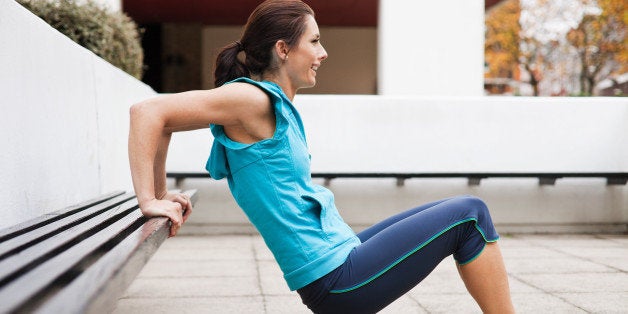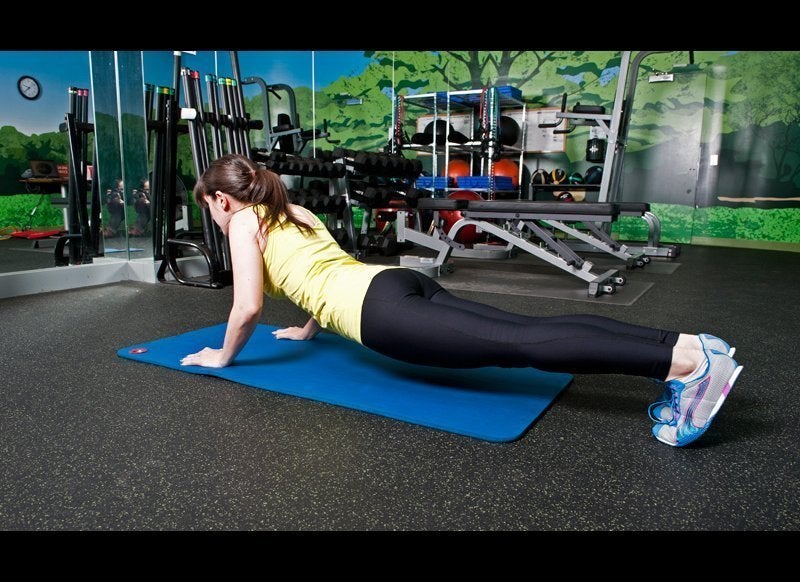
By Jessica Matthews for Shape.com
Sporting strong, well-defined arms is a fitness aspiration of many, and to effectively target the triceps -- the muscles in the back of the upper arms -- many people find themselves torn between two common moves: bodyweight bench dips and dumbbell triceps kickbacks. To get insight on both of these exercises and evaluate the benefits and the potential risks of each move, four top personal trainers share what you should consider before making your exercise selection.
Bodyweight Bench Dips
A no-equipment exercise that can be done just about anytime, anywhere -- from the edge of your living room couch to the bench at the gym -- bodyweight dips offer many benefits. A study by the American Council on Exercise (ACE) found this exercise to be one of the most effective moves for eliciting a high level of muscle activity in the triceps, but that's not the only muscle it challenges. Don Bahneman, CSCS, general manager at VIDA Fitness Renaissance in Washington, D.C., says this movement also stimulates many synergistic muscles, including those in your chest, shoulders and upper back.
More from Shape.com:
Good-Bye Batwings! 5 Moves for Toned Triceps
5 Sexy Shoulder Sculptors
The Ultimate Arms and Abs Workout
This functional exercise mimics everyday pushing movements like lifting yourself out of a chair, but it can put too much stress on the anterior shoulder, the most vulnerable and most often injured part of the shoulder, says Chris McGrath, an ACE senior fitness consultant and founder of Movement First in New York City. Since it also increases shear forces in the shoulder joint and can add the potential for impingement of nerve endings, those with a history of shoulder issues or poor shoulder flexibility should proceed with caution, McGrath advises. First learn shoulder stabilization techniques so you can execute dips with proper form.
Dumbbell Triceps Kickbacks
A commonly-performed exercise that too ranked as one of the top three most effective moves in the ACE triceps study, kickbacks simply require a pair of dumbbells and are typically less challenging in terms of shoulder and core stabilization, making them a good choice for learning how to target the triceps, says Sabrena Merrill, an exercise scientist and ACE spokesperson based in Kansas City, MO. However, like dips, form is imperative in order to reap the benefits, and the positioning of the body needed for this move may prove challenging for some.
"The kickback requires holding the shoulders at the end ranges of extension, but many people have limited shoulder range of motion, especially if they work at a computer," Merrill says. McGrath adds that many exercisers fail to lift their arms high enough during this movement: Your upper arms should be parallel with the floor. Lastly, you want to keep your back flat. For bent-over kickbacks, McGrath recommends practicing hip hinges to ensure good posture.
The Bottom Line
Both exercises offer a great deal of benefits to those who have healthy, pain-free shoulders with good mobility. To see if the moves are a fit for your body, do this test from Keli Roberts, an ACE-certified personal trainer and owner of Keli's Real Fitness: Stand facing a mirror and hold your arms out to the sides. One at a time, extend each arm overhead and then bend the elbow, bringing the hand behind the shoulder blades.
If your hands are positioned more than a hands-distance apart, Roberts recommends trying other triceps exercises. Overhead extensions target all three heads of the triceps in a "more mechanically advantageous position," Merrill says. Or do cable triceps extensions and lying triceps extensions -- commonly known as skull crushers -- as these movements can allow for protection against the momentum factor of an improperly performed bodyweight dip or kickback, Bahneman suggests. Also keep in mind that any type of pushing exercise -- such as pushups and bench presses -- works the triceps.
